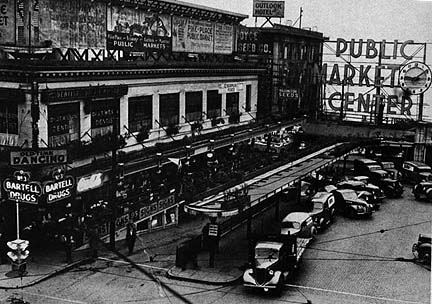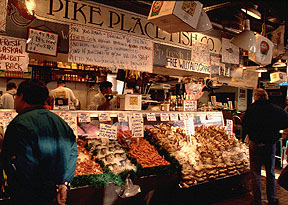
Seattle:
Pike Place Market

In 1907 Seattle's City Council designated an area on the coast referred to as Pike Place as a public market area. This market gave farmers an opportunity to sell their crops in the downtown. The market became an instant success and it grew rapidly. By 1917 much of the market as it is today was constructed. The construction during this time produced the Economy Market, Corner Market, Sanitary Market, and it finished off the lower levels of the Main Market. The market continued to prosper until World War II. During the W.W.II era business declined at Pike Place. The market lost half of its farmers when the Pearl Harbor attack led to the immurement of the Japanese and in 1941 the Sanitary Market was almost completely destroyed by fire. After the war the market struggled to regain its pre-war popularity. The people were no longer interested in farming, industry was taking over farmland, and the new supermarkets were attracting the consumers.

During the 1960s the number of consumer's shopping at the market reached an all time low. In 1963 a plan was created to demolish the market and create a new modern "Pike Plaza". This plan called for office towers, apartments, a parking structure, and a small up-to-date market. The citizen's of Seattle let it be known that they were strongly opposed to the redevelopment of the market. A group of those opposed formed the group "Friends of the Market". The leader of this group was University of Washington professor of architecture Victor Steinbrueck. Steinbrueck and his friends worked to get the market issue on the November 1971 ballot. The "Friends of the Market" succeeded in getting the issue on the ballot and they were awarded with a 60% vote from residents to preserve the Pike Place Market.
The passage of the issue created a 7 acre National Register of Historic Places and local market historic district and commission. The win also created the non-profit Preservation and Development Authority (PDA) whose job was to restore and govern the market. The PDA was given 10 years and $150 million dollars of both private and public funds to restore and revitalize the market. One of the reasons that the Pike Place Market has been so successful is that the restoration and use of the market was very strictly laid out. The city created an ordinance that protected the structure from demolition and protected the character of the market. The ordinance stated that if a structural material needed to be replaced it should be replaced with a material of the same quality as the original material and it stated that a product must either be made or grown by the vendor to be sold at the market. The result as stated by George Bartholick, the principle architect of the market's restoration, is that: "This project, in contrast to most architectural work, was similar to restoration of a mountain meadow: If the work is done well, no one is aware of the presence of new hands". These provisions have helped to create the vital and bustling Pike Place Market of today.

Another reason the Pike Place Market has been so successful is because it has been preserved as a place where people of all income levels can live and shop. From it's beginning 92 years ago it has always been a place where small local farmers and crafts people can sell their goods. The streets and sidewalks of the market are a bustling, energetic place where shoppers, vendors, tourists, bums and street musicians create an inviting atmosphere. The result of the restoration and preservation of Pike Place Market was, to say the least, successful. Today, the market has become a "pedestrian-friendly neighborhood right in the heart of the city".
Sources:
Paul Dunn, "Welcome to the Pike Place Market Historical District" www.ci.seattle.wa.us/don/uc/33.htm.
"History of Pike Place" http://www.ci.seattle.wa.us/don/uc/34.htm
Donald Canty, "Pike Place Market," Architecture, May '85, p. 274-81.
Tim Appello, "Rescue in Seattle Pike Place Market and Pioneer Square," Historic Preservation, Oct '85, p. 35-39.
Mark Higgins, "Seattle's retail boom makes it harder for Market to sell itself," www.seattle-pi.com/pi/neighvors/pikeplace/sell21.html, June 21, 1997.
Mark Higgins, "Selling the personal touch is key to remaining vibrant," www.seattle-pi.com/pi/neighbors/pikeplace/, June 21, 1997.
Jane Hadley, "The Market: A Landmark in Flux," www.seattle-pi.com/pi/neighvors/pikeplace/pike29.html, June 29, 1998.
"The Numbers," www.seattle-pi.com/pi/neighbors/pikeplace/numbers.html, June 21, 1997.
Mark Higgins, "This Place is not just for show," www.seattle-pi.com/pi/neighbors/pikeplace/, June 21, 1997.
Mark Higgins, "Visionary saw Market as a social center," www.seattle-pi.com/pi/neighbors/pikeplace/, June 21, 1997.
Page Author: Kelly Kolakowski
| Physical Strategies | Functional Strategies |
|---|
.
